9 Popular Floor Materials for Your Home
If you’re excited about your home renovation, you’ll want to make sure every aspect of your new home is exactly the way you dreamed it, starting with the basic foundation. That means choosing floors that will complement the design and function of each room as well as create a cohesive overall appearance. Ready to get started? This extensive guide will not only provide you with detailed information on the 9 most popular flooring materials available, but it will also share some knowledge of which floors are best in which rooms and why, as well as provide a visual comparison between materials to provide a thorough understanding of what each option has to offer.
How to Choose Your Materials
While there may be a multitude of factors that determine what floors are right for your household, the short list of questions below covers the most important ones, to help narrow down your options (and limit your stress).
· What is the visual aesthetic of my home overall/of each room in my home?
· Will my floors need to accommodate babies, pets, elderly folks, or individuals with disabilities?
· Do any members of my household have allergies to certain materials or particles such as dust or pollen?
· What is my budget for flooring?
· Do I want to DIY or hire an installer?
· Which rooms need water-resistant flooring?
· How important is durability and/or a long lifetime?
Once you’ve answered these questions it’s time to play a fun matching game. Pair the right floor material with the right room to win a beautiful, cohesive, and functional home design!
Meet the Materials
1. Hardwood

The most popular choice amongst homeowners, hardwood floors raise the value of your home with their natural elegance. A variety of wood options are available, among which maple and oak are the most common, and the color scheme ranges across a neutral palette. The natural grain of the wood adds a nice earthy touch.
Maintenance: Resealing every 5 years.
2. Bamboo
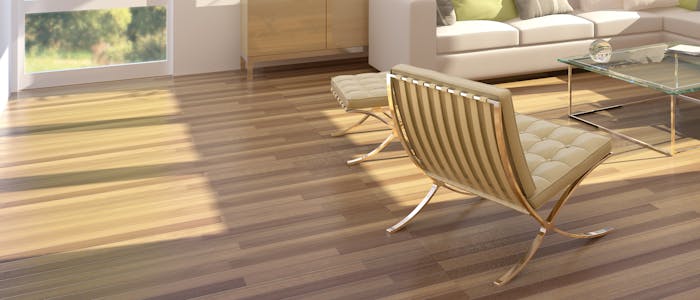
This material greatly resembles hardwood but is available in only one wood type: bamboo. However, since the natural color options are limited to one, bamboo is generally dyed to provide more variety in the way of design. There are also three different types of bamboo planks to choose from: vertical, horizontal, and strand woven.
Maintenance: Resealing is not needed.
3. Natural stone
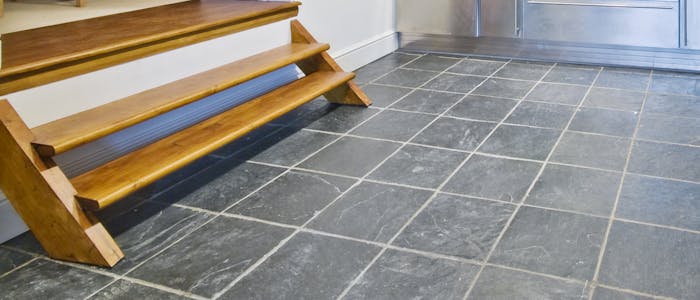
As versatile as it is beautiful, Natural Stone floors provide a large and varying spectrum of material options. The most popular choices are marble, granite, limestone, sandstone, and travertine, each of which is available in a variety of colors and finishes. Since the tiles are formed from a natural material no two will be alike, making your floor one-of-a-kind.
Maintenance: Resealing every 6 months to 2 years.
4. Concrete

Many mistake concrete as being a boring material, and utilize its strength in spaces such as garages where appearance is not important. However, if done right, concrete floors can offer a lot in the way of design. The material is surprisingly versatile since it can be dyed, stained, painted, and polished into a beautiful and stylish floor.
Maintenance: Resealing every 1 to 2 years.
5. Linoleum
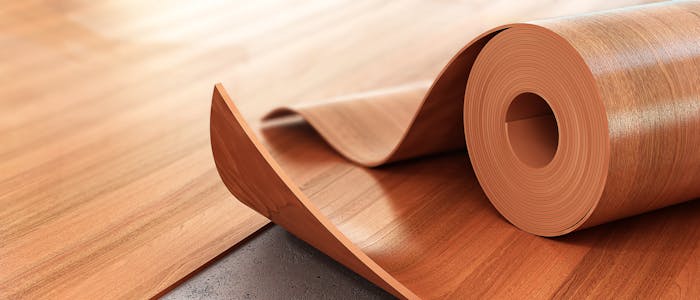
The outdated linoleum of the past is gone, replaced by a newer version that is fit for the modern home. This material made a comeback when homeowners discovered that the new material is bio-degradable and all-natural making it very environmentally friendly. Additionally, linoleum is a synthesized material meaning it is available in an endless variety of colors and styles.
Maintenance: Resealing every 1 to 2 years.
6. Vinyl
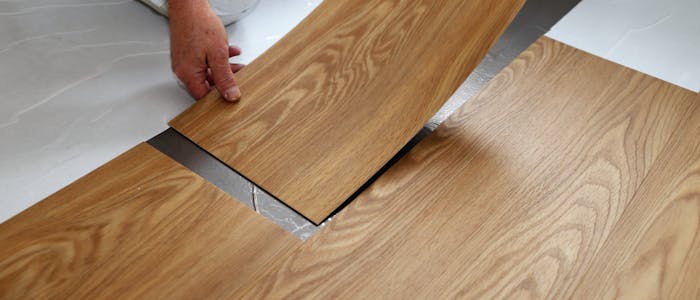
Another synthesized material, Vinyl is an economical replacement for natural materials, as it can be printed to mimic the appearance of any material as well as any other style you desire. It is available in three main options: Vinyl tiles, Vinyl planks, or peel and stick.
Maintenance: Resealing every 3 to 10 years.
7. Laminate
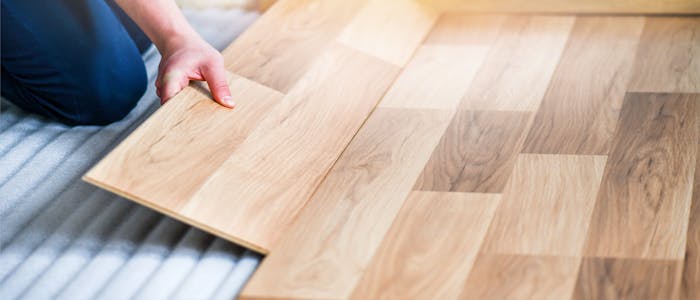
Composed of multiple layers of different materials to form beautiful and durable flooring planks, laminate flooring is often found in both high-end and budget-friendly homes in place of hardwood. It can also be crafted to mimic other materials such as stone and is a reliable and versatile floor option.
Maintenance: resealing or replacing every 5 to 12 years.
8. Tile (Porcelain/Ceramic)
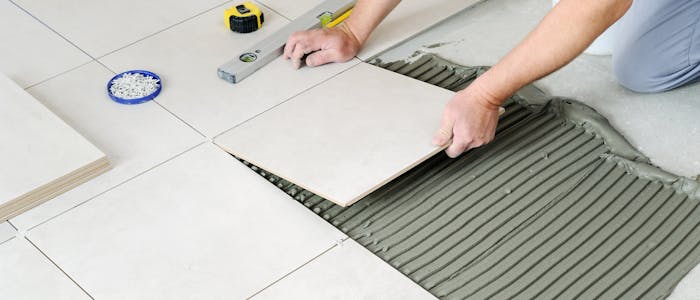
A well-loved and classic choice, the versatility of tile flooring is rooted in the variety of color, style, and layout options it provides. Proven to be ideal for high moisture spaces such as bathrooms, this material is practical as well as timeless.
Maintenance: Resealing every 4 to 5 years.
9. Carpet
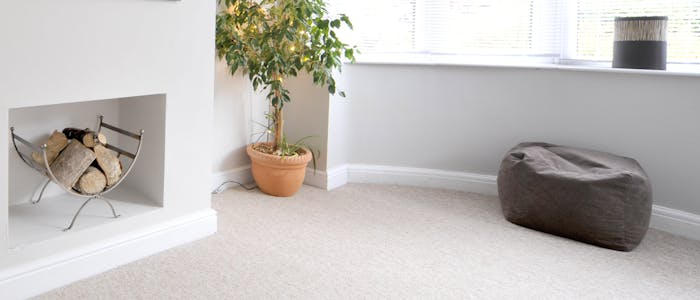
Of all the options, carpet provides the most stylistic freedom. It is available in a wide selection of materials in any imaginable color and pattern that can be perfectly matched to the other visual aspects of your home. However, that versatility and soft feeling underfoot come at the price of low durability and strenuous cleaning.
Maintenance: Deep cleaning every 12 to 18 months.
(Note: The maintenance mentioned above is not required, but is recommended since it keeps your floors in prime condition.)
A Visual Comparison

(Note: Lifespan is dependent on the quality of the material and installation. All costs listed above include installation)
Water Resistance/Durability: A Closer Look
Hardwood: This material is highly durable but easily scratched; it can handle small amounts of water as long as it’s dried quickly, but should not be installed in a humid environment.
Bamboo: This material is highly durable and scratch-resistant; when sealed properly it is more moisture-resistant than hardwood, but still not entirely waterproof.
Natural Stone: This material is highly durable and somewhat scratch-resistant, chipping and cracking can occur but are uncommon, it is porous and absorbent but can be waterproofed with sealant.
Concrete: This material is highly durable and scratch-resistant, but can crack with environmental changes; it is porous so it will likely absorb water.
Linoleum: This material has average durability and can be punctured or scratched; it is likely to suffer damage like curling at the edges if installed in a humid environment.
Vinyl: This material has average durability but is scratch-resistant; it is generally resistant to moisture, but the strength of its resistance varies based on the installation and the number of seams in the floor.
Laminate: This material has average durability and is semi-scratch-resistant; the floorboards can get warped and rotted from moisture so it should not be installed in a humid environment.
Tile (porcelain/ceramic): This material has high durability and is scratch-resistant, while it is highly moisture-resistant, the grout it’s applied with can absorb water, loosening the tiles.
Carpet: This material has low durability, and gets easily worn with age; it is highly absorbent of moisture and can grow mold/mildew in humid environments.
DIY Difficulty: Installment/Repairs
Hardwood: Installation and repairs are difficult to DIY; professional help is recommended for inexperienced individuals.
Bamboo: Installation and repairs are difficult to DIY; professional help is recommended for inexperienced individuals.
Natural Stone: Installation and repairs are difficult to DIY; professional help is recommended for inexperienced individuals.
Concrete: Installation is difficult to DIY, but repairs can be moderate depending on the level of damage; professional help is recommended for extensive damage or water damage.
Linoleum: Installation and repairs are relatively simple to DIY; professional help is usually not required.
Vinyl: Installation and repairs are very easy to DIY; professional help is not required.
Laminate: Installation and repairs are very easy to DIY; professional help is not required.
Tile (porcelain/ceramic): Installation and repairs are moderately uncomplicated to DIY if you’re experienced but difficult if you’re inexperienced; professional help is recommended for inexperienced individuals.
Carpet: DIY is difficult for installment but can be moderately simple for removal/repairs depending on the material; professional help is recommended.
Best Floors by Room
Kitchen: Vinyl floor– Recommended for its high moisture resistance and allergy-friendly nature.
Bathroom: Tile floor– Recommended for its high moisture resistance and easy cleaning.
Bedrooms/Playroom: Laminate floor– Recommended for its soft surface, easy cleaning, and versatile style/color options
Dining room: Hardwood or bamboo floor – Recommended for their durability and classic timeless elegance
Family/Living Room: Carpet floor – Recommended for its soft, cozy surface and homey appearance
Garage/Basement: Concrete floor– Recommended for their lasting strength and hard surface
Foyer: Natural stone floor– Recommended for its ability to withstand heavy foot traffic and natural beauty
The suggestions above are based on the quality of the materials in relation to the functions/foot traffic of each room, but feel free to find your own way of utilizing these floors in your home.
It’s Decision Time
We hope this comprehensive guide helped you learn everything you need to know to choose and lay down the perfect foundation for your brand-new home. We can’t way to see how you utilize these floors to create a cohesive and functional design.
Happy designing!
